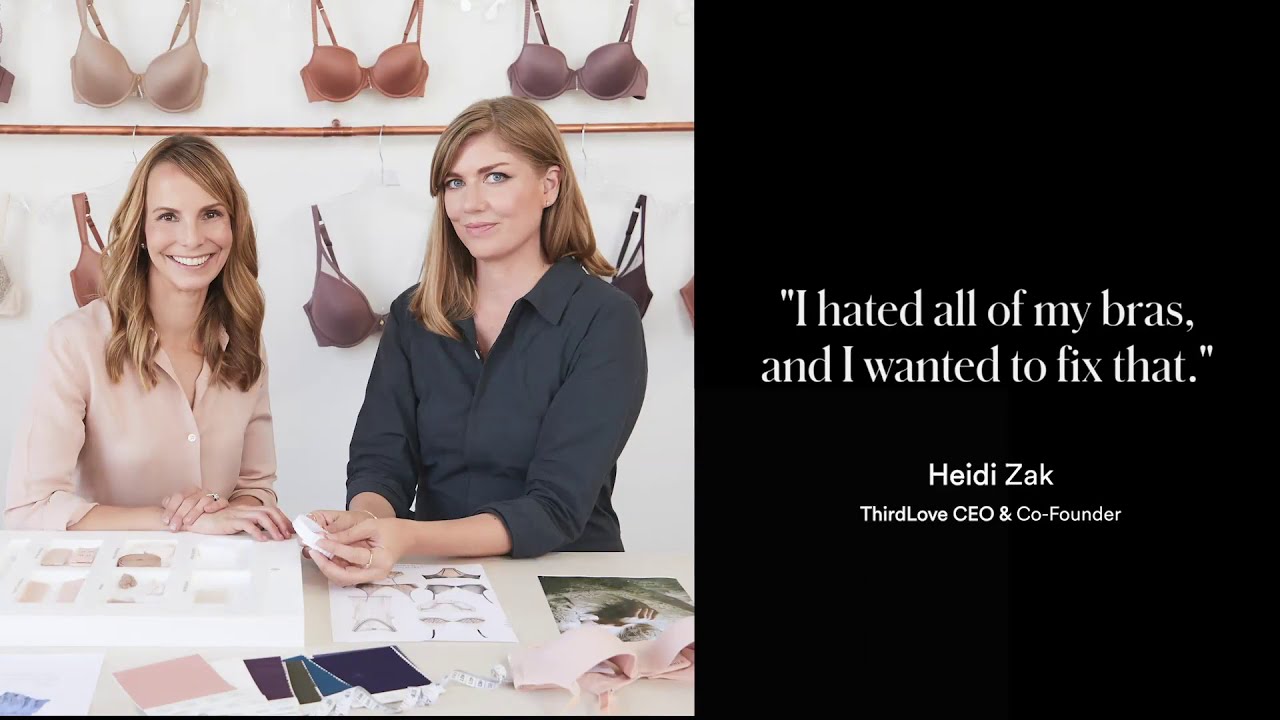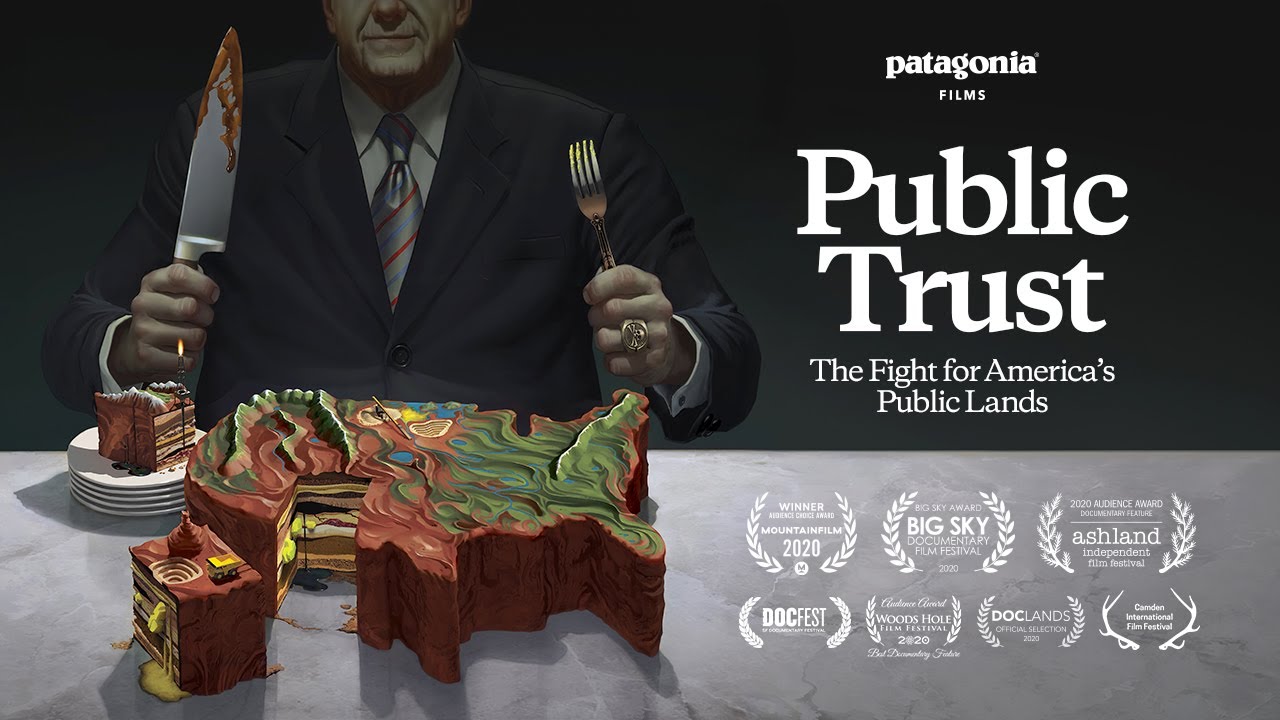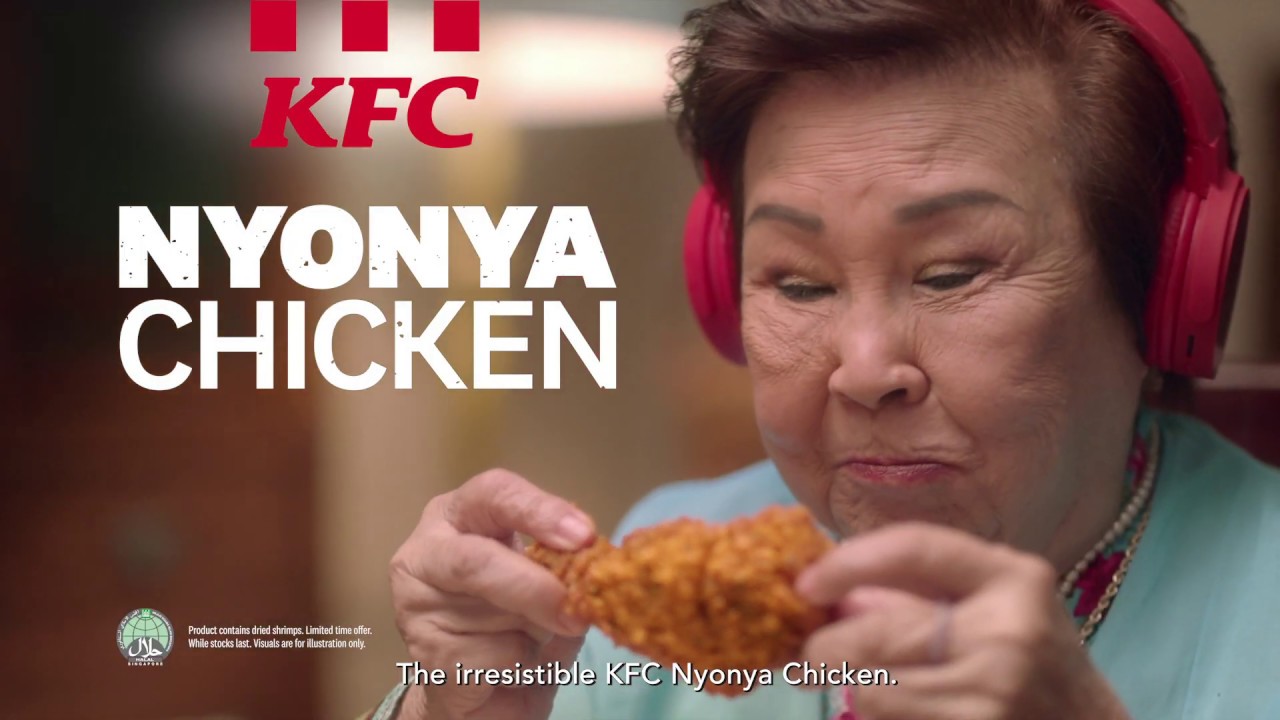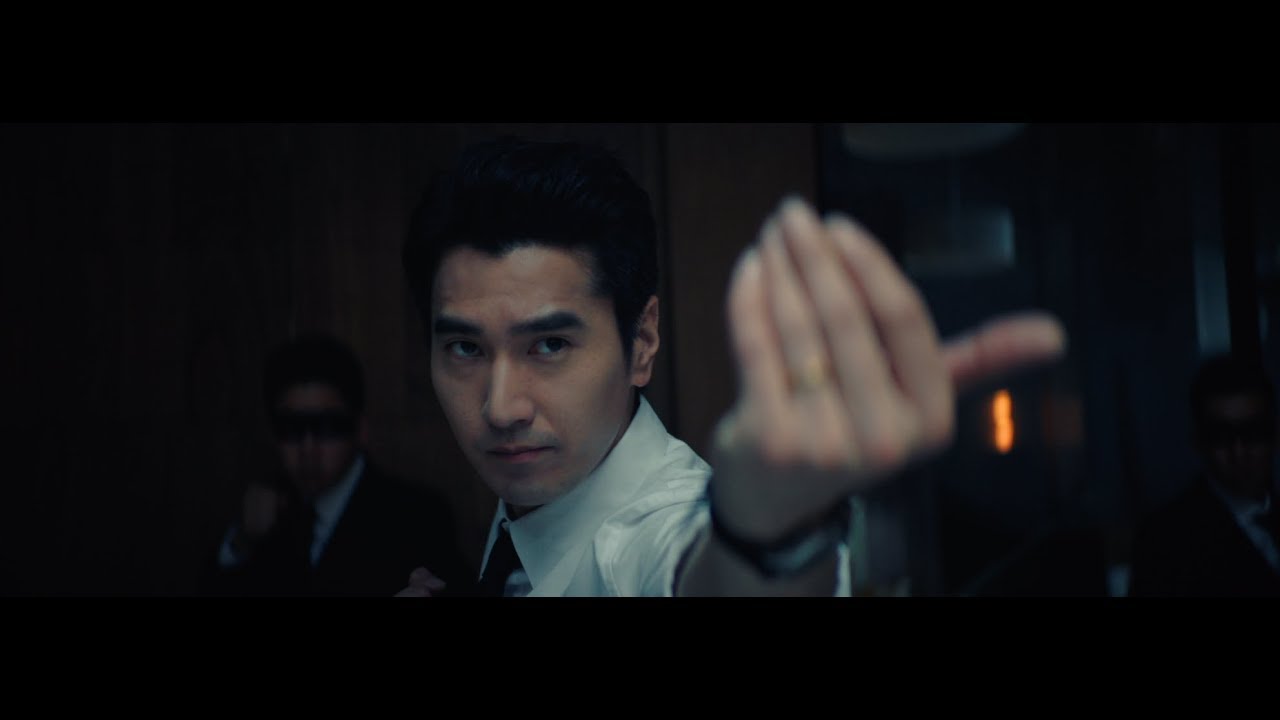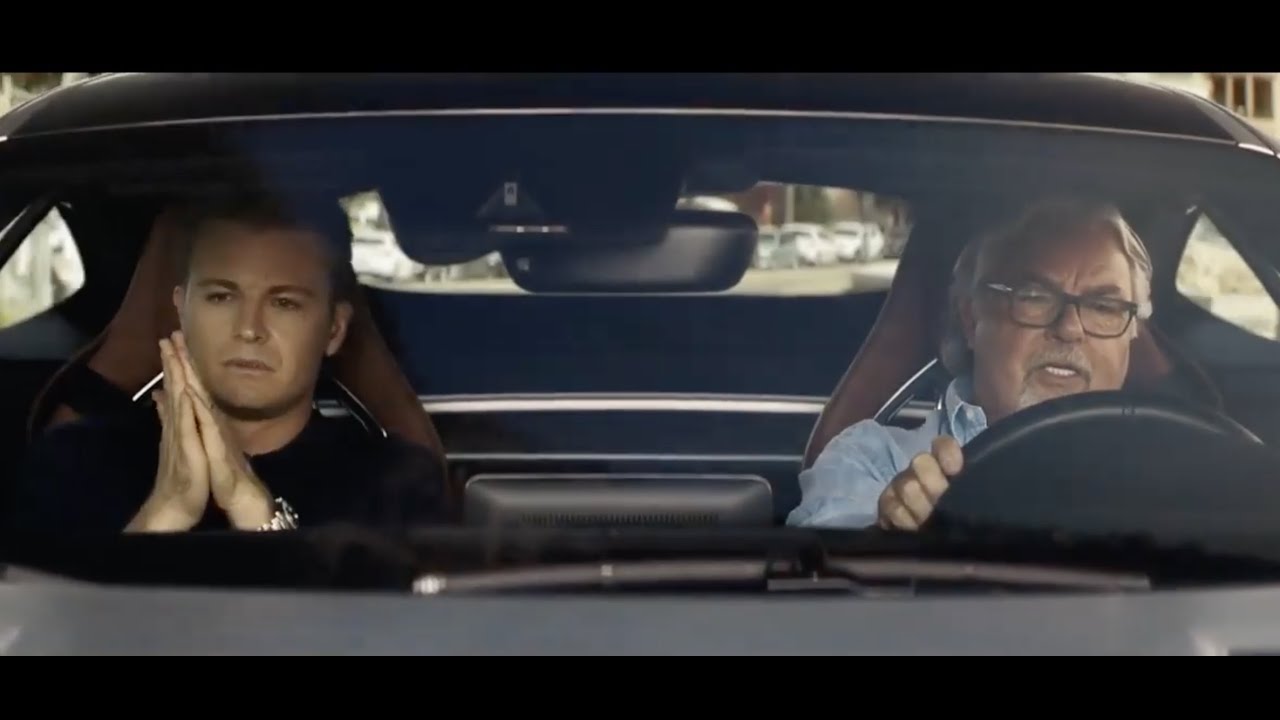3 brands that prove authenticity in marketing is paramount
What is authenticity in marketing? Authenticity in marketing is brands creating marketing strategies that reflect their core values even if these strategies go against the norms or business standards.
Lingerie brand ThirdLove doesn’t feature slim supermodels to sell its bras, outdoor clothing company Patagonia asks its customers to buy less on Black Friday and ice cream maker Ben & Jerry’s calls upon everyone to dismantle white supremacy which prompted thousands of people to accuse the company of being anti-law enforcement.
ThirdLove – To all women everywhere, we see you and we hear you
Founded in 2013, Third Love is producing and selling bras and underwear.
The company was the first bra and underwear brand to offer trademarked half-cup sizing and a mobile app allowing women to measure themselves at home.
It all began with co-founder Heidi Zak’s frustration with lousy bras and bad fits. That’s when she decided to build her own bra thus Third Love was born.
Third Love celebrates diversity; it’s one of the company’s main core values and it reflects in their marketing.
Just as the company designs their bras with real women’s measurements, their marketing campaigns and overall online presence feature women of all shapes and sizes.
Such a difference from Victoria’s Secret! The luxury lingerie brand was once the leader of the underwear industry. By 2018, due to a combination of dated business approach, oversexualized images and heavy competition, the brand’s market share had begun to shrink from 31% in 2013 to 24%.
Also in 2018, Third Love had a run-in with Victoria’s Secret over the interview that the brand’s CTO gave to Vogue Magazine.
In this interview, he basically said that Victoria’s Secret supports the woman as long as she portrays herself as the object of the heterosexual white male’s fantasies.
He also hinted toward Third Love by saying “We’re nobody’s ThirdLove, we’re their first love.” This prompted Heidi Zak’s reaction in the form of a full-page open letter published in the New York Times where she writes:
As you said Ed, “We’re nobody’s ThirdLove, we’re their first love.” We are flattered for the mention, but let me be clear: we may not have been a woman’s first love but we will be her last.
To all women everywhere, we see you, and we hear you. Your reality is enough. To each, her own.
View this post on Instagram
Patagonia – We’re in business to save our home planet
Patagonia is a clothing company that markets and sells outdoor clothing.
The company was founded by Yvon Chouinard in 1973 and considers itself an “activist company”. They’re in business to save our home planet and will use every resource at their disposal – their voice, business and community to solve the climate crisis.
The brand talks the talk and walks the walk. The company has a self-imposed Earth tax, 1% for the Planet, which it uses to provide support to environmental nonprofits working to defend air, land and water around the globe.
Since 1985, when Patagonia took this pledge, the company has donated over $89 million in cash. In 2019, it is estimated that the company had $800 million in revenues.
Patagonia is followed by almost 1,8 million people on Facebook and 4,6 million on Instagram. They are building a strong community online and offline.
The company’s marketing strategy is to support its activist-led campaigns (like the company’s anti-Black Friday ad Don’t buy this jacket). To achieve this goal, Patagonia uses storytelling to turn consumers into activists. Its online presence features only a few scattered sales posts.
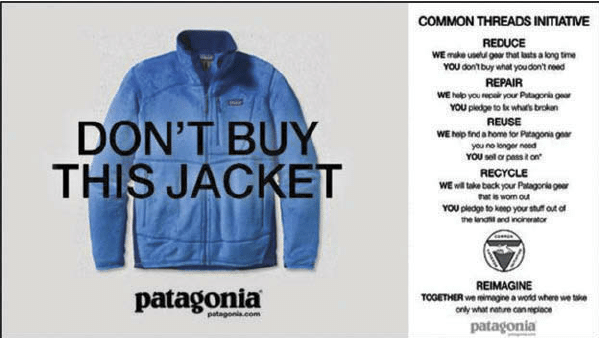
Ben & Jerry’s – Democracy is in your hands
Ben & Jerry’s manufactures ice cream.
It was founded in 1978 by Ben Cohen and Jerry Greenfield, hence the company name.
The company’s mission is to create prosperity for everyone that’s connected to its business: suppliers, employees, farmers, franchisees, customers, and neighbours alike.
They care about a wide range of issues from racial justice to fairtrade, democracy to LGBT equality.
Why does an ice cream maker care about political and social issues?
In an HBR piece published earlier this year, Ben&Jerry’s CEO Matthew McCarthy answered this when asked about the company’s core commitment to speak out on issues they feel strongly about:
We do these things not to sell more ice cream but because we care about people and have values. All businesses are collections of people with values; it’s a force that’s always there. {…} I believe that increasingly, in a world of hyper-transparency, if you’re not making your values known publicly, you’re putting your business and brand at risk.
The latest reports on consumer behaviour are highlighting that fact that most consumers (86%) want brands to take a stand on social issues and they would also purchase a product because a company advocated for an issue they cared about (87%).
What consumers are asking brands today is not what do you stand for but what do you stand up for?
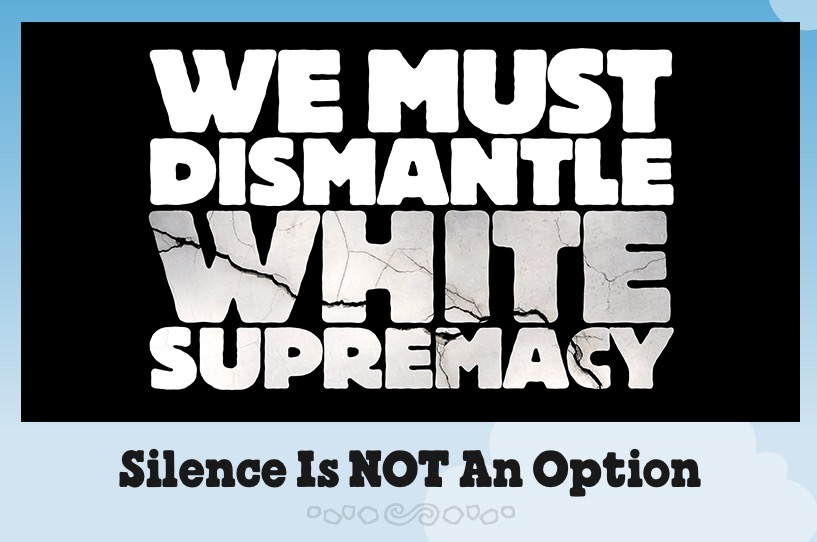
Here is Matthew McCarthy’s recommendation for companies looking to make activism part of their core values:
If you don’t know what you want to do, talk to your staff, get people together, create the space for this discussion around values. You could decide that your thing will be The Humane Society. It could be packing lunches. It can be anything. What it can’t be is nothing.
Join the Conversation
We’d love to hear what you have to say.
Get in touch with us on our LinkedIn Page, Facebook Page, Twitter or TikTok.
Porter’s Diamond Model analysis: Louis Vuitton and BMW
Learn about the business strategies used by Louis Vuitton and BMW from Porter’s Diamond Model analysis of these two successful and powerful organizations.
The Porter Diamond Model, also known as the Porter Diamond Theory of National Advantage is a business framework that describes a nation’s competitive advantage in the international market.
The model also highlights four factors that companies looking to expand their business internationally can take advantage of to achieve competitiveness in the market.
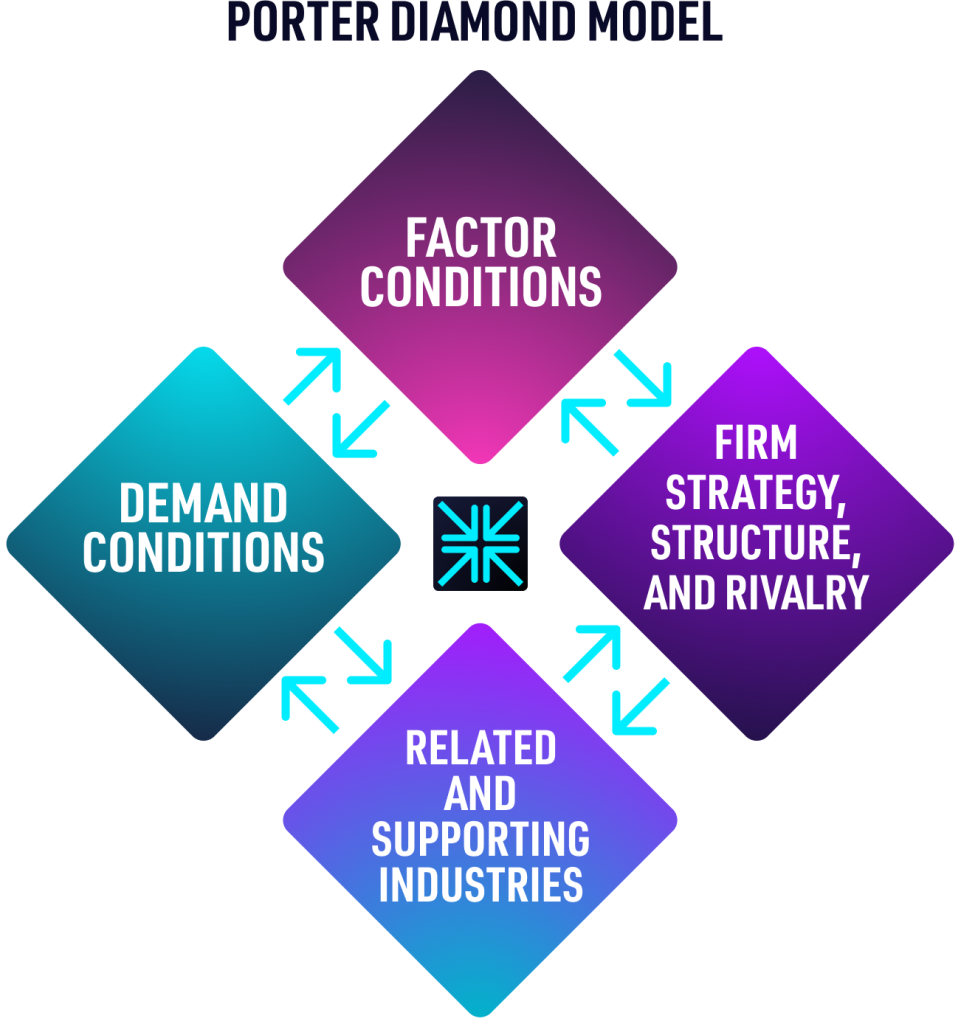
The Porter Diamond Model includes 4 attributes
The Porter Diamond Model analyzes a nation’s advantage against four broad attributes that each nation establishes and operates for its industries:
1.Factor Conditions
This attribute defines the nation’s position in factors of production, such as labour, land, natural resources, capital or infrastructure, necessary to compete in a given industry.
2. Demand Conditions
The second attribute of the Porter Diamond Model refers to the nature of home-market demand for the industry’s product or service.
3. Related and Supporting Industries
This attribute reveals the presence or absence in the nation of supplier industries and other related industries that are internationally competitive.
4. Firm Strategy, Structure, and Rivalry
The Firm strategy, structure and rivalry attribute highlights the conditions in the nation governing how companies are created, organized, and managed, as well as the nature of the domestic competition.
For in-depth information on Porter’s Diamond Model, check out this article!
Theoretical knowledge is good but it’s only the starting point. Analyzing real-life examples is the best way to learn about a new business framework or model. It helps you put things in perspective.
For the purpose of this article, let’s look at two global brands and how the Porter Diamond Model is applied to them: Louis Vuitton and BMW.
Porter’s Diamond Model Analysis of Louis Vuitton

With a brand value of over $51 million in 2020, Louis Vuitton is the most valuable luxury brand in the world.
France is the company’s home base but since its inception more than 150 years ago, Louis Vuitton has expanded in 50 countries and has a retail network of over 4,910 stores worldwide.
What is the secret of Louis Vuitton’s success? Read Louis Vuitton: The story behind the brand.
Louis Vuitton: Factor and demand conditions
When you think of luxury, you think of France.
France is the world’s capital for luxury goods, haute-couture fashion, cosmetics, perfumes and accessories and the home for famous international houses such as Chanel, Dior, Givenchy, L’Oreal, Clarins, Lancome, Hermes, Celine, Louis Vuitton etc.
It’s not by chance that France has such a strong cluster of luxury brands.
The country’s luxury goods industry has a long history which began more than 500 years ago.
Eight hundred years ago, France was Europe’s silk centre with a booming silk industry.
King Louis XIV, the country’s most fashionable royalty recognized the importance of luxury goods to the national economy. Under his leadership, the country developed a powerful textile industry which in turn boosted trading and the country’s infrastructure.
Fast forward to the 21st century, France is synonymous with high fashion and luxury goods.
The fashion and luxury goods industry has a direct turnover of €150 billion. The share of French GDP generated by fashion is 2.7%. There are 1 million jobs in the fashion industry (source). The workforce in the industry is highly skilled. Experienced craftsmen or seamstresses sometimes receive an 18-month to 2-year training.
France was the perfect country for Louis Vuitton to be born in. The country provided the luxury brand with perfect factor conditions.
The French are known for their good taste and high fashion style so the brand had to work hard and innovate to meet the needs of such demanding customers (demand conditions).
This, in turn, helped them expand internationally and retain their competitive advantages.
With 37% of global sales, the Asian market is Louis Vuitton’s biggest revenue source.
Surveys show that 92% of Japanese women own a Louis Vuitton handbag and sales in China rose by more than 50% and in August last year when the brand reported record sales at its largest store in Shanghai.
Louis Vuitton: Related and Supporting Industries
The country also ranks high in the Related and Supporting Industries attribute for the luxury goods industry.
The industry’s development has been in close relationship with many subsectors such as textile and apparel, garments and embellishments, and sewing machinery. It’s an ecosystem whose members pressured each other to improve and innovate for mutual benefit.
Louis Vuitton: Firm Strategy, Structure, and Rivalry
In France, the luxury goods industry is highly competitive.
With pressure from competitors, online sales increase and technology disruption, Louis Vuitton’s business strategy is to grow through acquisitions.
The brand is part of LVMH, the world’s largest conglomerate which came to be in 1987 when Louis Vuitton merged with champagne and cognac producer Moët Hennessy.
Over a period of 34 years, LVMH acquired more than 70 famous luxury brands. The latest acquisition is Tiffany & Co.
Porter’s Diamond Model Analysis of BMW
BMW: Factor and demand conditions
Germany played a major role in the history of the automotive industry.
It was Karl Benz, a German mechanical engineer who designed and, in 1885, built the world’s first practical automobile to be powered by an internal-combustion engine. Today, Germany is renowned for its powerful and innovative cars.
The largest industry sector in Germany is the automotive industry. Vehicles make up almost 17% of total exports.
The automobile industry generated roughly 426 billion euros in total sales in 2018.
With 882,000 manufacturing jobs in the automotive industry, Germany ranks first among European countries.
The country is a primary location for innovative car manufacturers and suppliers and is home to powerful brands such as BMW, Audi, Volkswagen, Mercedes etc.
One of the factors underlying German success is that the workforce is created. German students benefit from the country’s dual system of education where they combine vocational education with apprenticeships. This type of education supplies the country with a steady flow of highly skilled workers.
The German automotive industry benefits from a strong industrial core, first-class infrastructure, a highly-skilled workforce and cutting-edge research and development.
BMW has become a prestige global brand, operating 31 plants in 14 countries, including the largest car manufacturing plant in the world.
BMW has taken advantage of the factor conditions provided by the country. Ranked 2019’s 3rd most valuable car brand in the world, the company didn’t start as a car manufacturer, but as an aircraft engine manufacturer.
The brand’s success relies on its outstanding car design, technological innovation and workforce.
As the Porter Diamond Model recommends, the brand grows its own workforce. The BMW Manufacturer-Specific Advanced Training (MSAT) program provides students with extensive training on BMW vehicles thus preparing them to work for the company.
BMW: Related and Supporting Industries
BMW cars are high-quality automobiles.
The brand carefully selects suppliers in subsectors of the automotive industry such as parts and components, heating, ventilation, air conditioning, electronics etc. BMW depends upon a network of over 100 auto parts suppliers from all over the globe, though approximately 50% of its suppliers are either located in Germany or are subsidiaries of German-based companies (source).
BMW: Firm Strategy, Structure, and Rivalry
BMW faces tough competition both domestically and internationally.
The company’s competitors are legacy brands much like itself.
On the local market, car automakers differentiate themselves through brand positioning.
In recent years, German car manufacturers have been struggling to adapt to new technological challenges (car connectivity, e-mobility), environmental challenges (green technology) and new entrants such as Tesla.
To stay ahead of the competition, BMW is using a competitive strategy which builds on market relevance, competitive services and research and development.
And it continues to make cars that consumers can emotionally relate to.
Attend the BUSINESS STRATEGY MASTERCLASS, on October 27 and learn future-proof business strategies for your organization from Costas Markides, Professor of Strategy & Entrepreneurship at London Business School.
Limited number of seats. Get your tickets today!
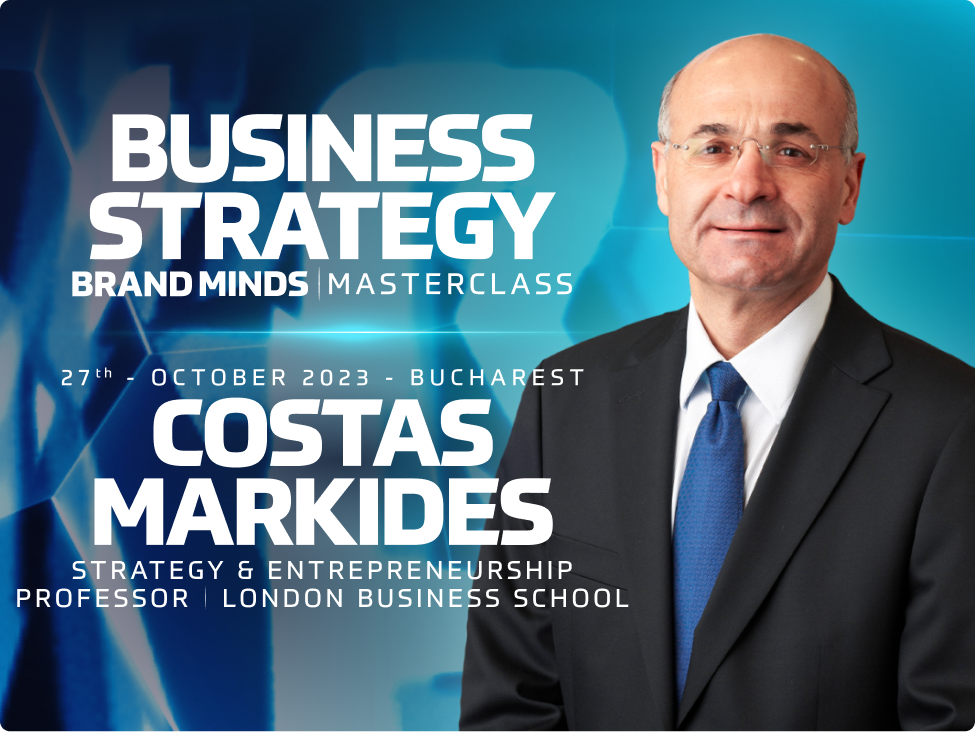
Hofstede’s cultural dimensions theory in advertising: KFC, BMW and Heineken
Hofstede’s cultural dimensions theory is a framework for measuring cultural dimensions from a global perspective. It is a useful business tool which provides insights for organizations looking to extend their business internationally.
I was curious to know if this tool is relevant in advertising so I selected three brands, KFC Singapore, BMW China and Heineken Italy and analyzed one ad for each brand.
To learn the Hofstede rankings of each country, I used this tool.
KFC Singapore

Power distance 74
Watching this ad by KFC Singapore, I see three cultural dimensions at play: power distance, individualism vs collectivism and masculinity vs femininity.
According to Hofstede’s theory estimations, Singapore ranks 74 at power distance. Power distance is the extent to which the less powerful members of organizations and institutions accept and expect that power is distributed unequally.
Singapore’s high score on this dimension indicates that it is a society that values hierarchy. This can be seen in the Singaporeans’ family meals customs which say that no one eats until the oldest member of the family lifts the spoon. In Singapore, older people are respected and listened to.
Individualism 20
The individualism vs collectivism dimension shows to which extent people feel independent or interdependent as members of larger communities. As you can see, Singapore ranks low in individualism which makes the society a collectivist one.
In the collectivist culture, family is at the heart of everything. A person views himself as a member of the family rather than an individual.
Masculinity 48
In regards to the masculinity dimension, Singapore ranks 48. Masculinity is the extent to which the use of force is endorsed socially.
Singapore’s rank tips the scale a little bit more to the feminine side. This means that conflicts are avoided and reaching a consensus is more important than being right.
What do we see in this ad?
We see a family preparing to eat together with the oldest, probably the grandmother sitting at the head of the table. As per tradition, everyone is inviting the grandmother to start eating. Although polite, what their invites do is repeatedly interrupt the hungry woman who doesn’t need convincing in front of a delicious bowl of KFC chicken. Because she doesn’t want to tell them off and ruin everyone’s good mood, she puts on a pair of headphones and starts eating with great pleasure.
BMW China

Power distance 80
This ad for the car manufacturer’s Chinese market pulls the strings on the viewer’s heart. It is longer than the average ad and uses this time to tell the story of a modern Chinese family with a hard-working white-collar father.
His son is trying to understand why his father is sometimes late to pick him up from kindergarten or even goes back to the office to work through the night. The only good reason he can think of is that his dad is a superhero and he gets wrapped up in doing superhero stuff.
China ranks very high in power distance. It is a country where subordinate-superior relationships tend to be polarized and can lead to power abuse by superiors.
We see this aspect of Chinese culture through the kid’s eyes: he imagines his father’s superiors as villains demanding him to dedicate his free time to the job and to making money because making money is more important than his son.
In his imagination, his father is fighting to overcome every obstacle that keeps him from coming home using every ability in his power: kung-fu strikes, negotiation or his bare fists. Like any other hero, he needs a sidekick to be successful and his BMW fulfils this role with flying colours.
Individualism 20
Chinese society ranks low in individualism. Although the ad focuses mainly on the kid, we can still see how important and how dedicated the father is to his son. He may be late, but he eventually shows up.
Masculinity 66
China is a masculine society where individuals are success-oriented and career-driven. And people have traditionally established roles.
As we can see in this ad, the mother is the child’s main caretaker and possibly a stay-at-home parent with the father having a well-paid job. Also, it’s not a coincidence that he is portrayed as a hero winning at everything he sets his mind to.
Heineken Italy
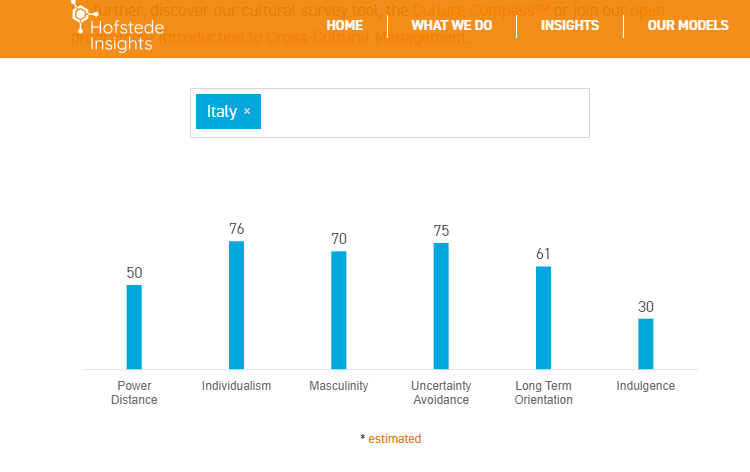
Masculinity 70
In this ad, we see Nico Rosberg, winner of the 2016 F1 World Championship and his father, Keke Rosberg, who also won the F1 World Championship, but 34 years earlier.
Competition is in their blood, both on the race track and in their father-son relationship also. Everything is a competition and winning is everything for this duo, from fishing the largest salmon to playing a game of tennis or throwing a paper ball into the trash can. And the loser gets to drive the car.
In the Behind the scenes video, Nico shares that to some extent, the ad reflects their relationship in real life. Playing a few games of tennis was a way for him and his father to spend time together.
Looking to expand your business into new markets?
Join BRAND MINDS 2023 and learn new strategies to create demand for your business from Renee Mauborgne, Bestselling Author of Blue Ocean Strategy.
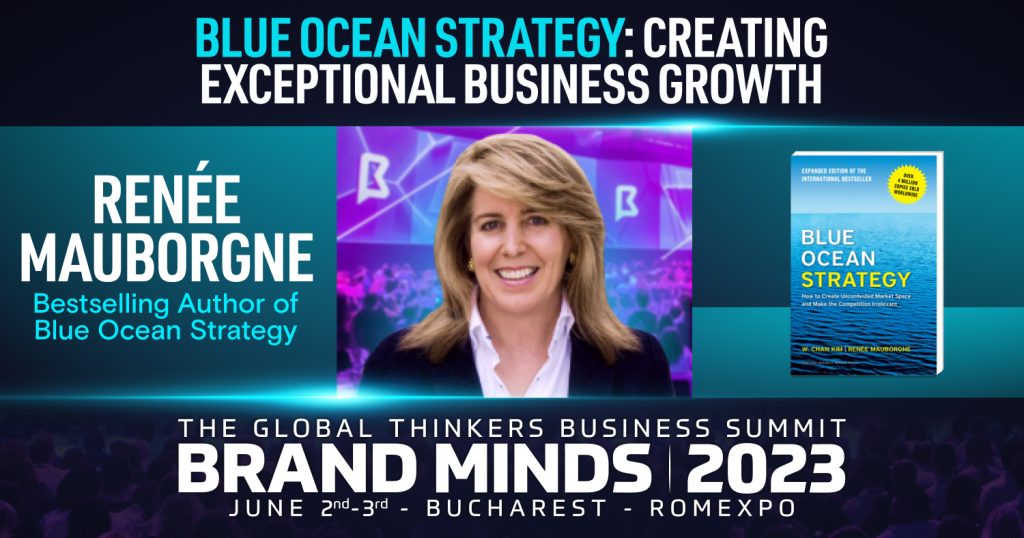
Join the Conversation
We’d love to hear what you have to say.
Get in touch with us on our LinkedIn Page, Facebook Page, Twitter or TikTok.
3 Brands Leveraging Nostalgia In 2018
As marketers, nostalgia is one of the most creative tools we have at our disposal. Many reports have shown that successful brands are those which establish an emotional bond with their customers. Therefore nostalgia is a way to make surprising connections in order to elicit an emotional positive response from our audience.
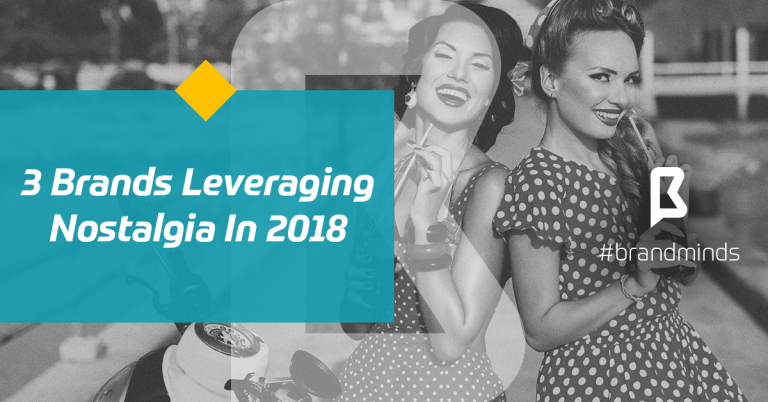
Here is how 3 brands leveraged nostalgia in 2018:
1. Google Assistant: Home Alone Again
Home Alone is one of the most iconic movies of the 90’s; it turned 18 years in 2018 and its leading actor, Macaulay Culkin is 38. And still the movie has been broadcast by Romanian televisions around Christmas time for the past 11 years uninterruptedly.
Google uses this particular cultural reference to advertise its virtual assistant to the adults who grew up watching Home Alone.
2. Tourism Australia – Dundee 2018 Trailer
What is Australia known for? Kangaroos, the Aborigines and … Crocodile Dundee, the 1986 movie. The main character, Mick Dundee has everything going for him: character, charisma and a big knife. He also knows his way around ladies, sweeping Sue Charlton, the American journalist off her feet. At the time, the female audience was enchanted by Mick Dundee’s relaxed masculinity and the male audience was charmed by the gorgeous and voluptuous Miss Sue. The movie made a lasting impact on movie-goers and is still a good film today.
Tourism Australia was right to leverage this movie’s huge popularity. The commercial is designed as a movie trailer for a supposed sequel to the 1986 Crocodile Dundee. The ad features many famous Hollywood actors born down under such as Hugh Jackman, brothers Hemsworth, Margot Robbie, Russell Crowe and American Danny McBride in the role of Mick Dundee’s long lost son.
The commercial hit the sweet spot big time! The video has over 3 million views and many are expecting it to become a full-fledged movie!
3. Coca Cola – The Wonder of Us
Unlike Google and Tourism Australia, in this commercial for the 2018 Super Bowl, Coca Cola uses nostalgia in a very discreet manner – if you don’t pay attention, you can almost miss it.
Coca Cola talks to the Gen Xers through their favourite activities and games they were playing when growing up: spin the bottle, playing with colourful balloons, rope swinging above water with your best friend or going on rides in bumper cars.
In this ad, nostalgia doesn’t play a leading role. Nostalgia helps Coca Cola deliver its main message about inclusion, celebration of sexual and cultural diversity, uniqueness, freedom, courage.
Expert’s Statement
Bogdana Butnar, Head of Strategy @Poke (Publicis UK Group) and marketing expert with 17 years of experience shared with me her opinion on nostalgia marketing:
Nostalgia is definitely an interesting tactical territory.
From a big picture point of view, I don’t think building a brand on nostalgia is wise, but you can do some interesting activations with it because Millennials and Gen Z are two generations who actively engage with the past.
Both Millennials and Gen Z have been described as having “complicated” relationships with the present, the former because it’s not allowing them to self actuate, the latter because it’s not what they expect.
Both generations look back with fondness to safer, more solid times when things were clearer and more stable. Gen Zers are particularly known to look up to their grandparents more than their parents or peers. This means that brands that were solid back in the day can hark back to those times to speak to this trust and longing for stability.
On the other hand, on a smaller scale, most of us have fond childhood memories of one brand or the other. We remember the candy grandma used to sneak us when we were visiting, a specific container design that signified we were getting something nice, or simply something that was so common that it became iconic.
All of those can be interesting tactical ways to engage a new audience by appealing to this “madeleine effect” that objects or flavours can have on us. And nostalgia is very easy to “identify” if you’re a brand that’s looking. People tag images of memorabilia, they proactively ”signal” that they miss something so it’s surprising more examples of nostalgia in marketing, through comms, packaging design, special editions etc, are not widely seen.
Join the Conversation
We’d love to hear what you have to say.
Get in touch with us on Facebook Group and Twitter.
These 7 Brands Used Augmented Reality Creatively in 2018
2018 has seen brands fighting tooth and claw to attract consumers’ attention. Competition is fierce in every market so successful brands are using digital tools to support their creativity.
Augmented Reality is one such tool and brands are using it to raise brand awareness, increase engagement as well as sales. According to emarketer.com, the global augmented reality ad revenues are expected to top $2 billion by 2022.

Let’s see how these 7 brands used Augmented Reality creatively in 2018:
1. National Geographic
The National Geographic is one of the oldest publishing houses in the world: this year it turned 130 years old (Happy Birthday, Nat Geo!).
The magazine managed to keep itself young and appealing to readers of all ages by embracing new and up-to-date channels of communication.
One of this year’s monthly edition delighted readers with an Augmented Reality cover:
2. Barilla
For retail products, the battle is fought on the shelves of the supermarkets.
Brands are implementing various marketing strategies to stand out and get their products from shelves to checkout: smart packaging design, discount prices, 2-in-1 offers etc.
Barilla joined the ranks of technology driven brands and used Augmented Reality for their pasta boxes to trigger pasta recipes:
3. LEGO
LEGO is kids’ favourite play game and the world’s largest toy company by revenues, with sales amounting to $2.1 billion in 2015. Founded in 1932, today’s parents grew up playing with LEGO and are passing down this game to their children.
Over the past years, the brand embarked on a new direction, shifting towards entertaining both kids and their parents with two blockbuster movies: The Lego Movie (2014) and The Lego Batman Movie (2017).
Everyone loved seeing the tiny yellow figurines coming to life on the big screen, so the brand now offers the same experience although on smaller screens using Augmented Reality.
This is what Lego in AR looks like as presented at the 2018 Apple Worldwide Developers Conference:
4. Moschino and H&M
Fashion and technology have a history together. Alexander McQueen was the first fashion designer to include robots: he used two robots in his 1999 fashion show. In 2006 he took it one step further and sent Kate Moss down the runway not in flesh and blood, but as a holograph.
In 2018, Dolce and Gabbana used drones to show its handbags collection and Moschino paired with H&M to create an Augmented Reality experience for their global launch event in New York:
5. Walmart
For retail chain stores, it’s not enough to display great products at discounted prices.
You need to go even further and add entertaining to your offer!
With the help of Augmented Reality tech, Walmart is providing its shoppers with in-aisle fun and entertainment.
6. BMW
For anyone passionate about cars, going to automobile events or launches and seeing so many shiny new cars on display would be a dream come true!
But not many people are fortunate enough to have such an experience.
BMW caters to their needs and uses Augmented Reality to bring the car to them:
7. 19 Crimes
Every wine label tells the story of the wine: how man and nature worked together to produce that particular wine variety.
What if you could use more than words to convey the story?
Well, now it’s possible.
Here is how this Australian wine brand uses Augmented Reality to tell the story of its lineup wines:
Join the Conversation
We’d love to hear what you have to say.
Get in touch with us on Facebook and Twitter.
5 Powerful Consumer Trends for 2019 from TrendWatching
Brands are no longer setting the pace for its consumers. In fact, it’s the other way around – these days, consumers have the upper hand over brands.
TrendWatching has identified 5 most powerful consumer trends which will influence brands in 2019.
Here they are:
- Legislative Brands
- Lab Rats
- Open Source Solutions
- Superhuman Resources
- Fantasy IRL
Let’s break them down and find out more about each one of them!
1. LEGISLATIVE BRANDS

In 2019, frustrated consumers will welcome LEGISLATIVE BRANDS: corporate interests using their significant power to call for, promote, and even impose laws that drive constructive change and make the world a better place.
TrendWatching
The concept of LEGISLATIVE BRANDS moves beyond brands supporting social issues and starting conversations by means of powerful marketing campaigns. Think Nike’s Dream Crazy and Iceland’s banned TV Christmas Advert Say Hello to Rang-tan – both powerful, both controversial. Read about them here.
In 2019, successful brands will step up their game and become a leader instead of a supporter. They will move past raising awareness; they will set out to influence and change the social issues that challenge the values they are passionate about.
The latest statistics show that more consumers link their shopping decisions to corporate values:
- 87% of consumers said they’d purchase a product because a company advocated for an issue they cared about (Cone Communications, 2017);
- 75% would refuse to purchase a product if they found out a company supported an issue contrary to their beliefs (Cone Communications, 2017);
- 86% of consumers want brands to take a stand on social issues (Shelton Group, June 2018).
Now, consumers are no longer just asking, ‘What do you stand for,’ but also, ‘What do you stand up for?’”
Alison DaSilva, Executive VP of CSR Strategy at Cone Communications
In August 2018, Microsoft published on the company’s blog the article Paid parental leave matters. In this article the company acknowledges the importance of paid parental leave which leads to “improved productivity, higher morale and lower turnover rates” and also helps “counteract gender caregiving stereotypes, neutralize stigmas and promote equity in the home and office.”
The tech company expresses concern regarding the insufficient number of companies which actively implement this policy – only 13%. As one of the largest employers in the world, Microsoft could have been satisfied with doing the bare minimum – implementing this policy. But the company didn’t stop here. Microsoft announced they will work only with suppliers which implement this policy within their organisation.
Your Turn
How committed is your brand to its values?
How willing is your brand to move beyond supporting the fight to going down in the trenches and fight the battle?
2. LAB RATS

Over the past few years, being healthy meant more than attending the annual physical check-up. Today there is a plethora of apps and platforms helping consumers achieve their health and wellness goals.
Learn more: Best Apps For Health Improvement
The global wellness industry is estimated to be worth over $3.72 trillion and 2018 is predicted to be the biggest year for wellness yet (source: welltodoglobal.com).
A recent survey shows that 80% of consumers are interested in health and wellness irrespective of generations – from Baby Boomers to Millennials (source: L.E.K. Consulting, July 2018).
In 2019, LAB RATS will see human wellness and lifestyle as an engineering problem to be solved. This outlook, with its origins in the Valley, will see rising numbers enthusiastically apply a test and fix approach to optimizing their health and lifestyle outcomes.
TrendWatching
Nestle, the company whose portfolio includes brands such as Kit Kat, Lion and After Eight has made a surprising and bold move entering the market of health conscious food. The company recently launched the “Nestle Wellness Ambassador” program in Japan. The program uses artificial intelligence and DNA testing to deliver personalised diets to its 10.000 users.
Your Turn
If your company is in the health and wellness sector, there are many opportunities you can take advantage of.
If your company is not part of this industry, you can still make the best of this trend. Ask yourself how your company can drive constant optimization. How can you empower your customers to understand, control, test and fix every aspect of their experience?
3. OPEN SOURCE SOLUTIONS

In 2019, the boldest and most inspiring organizations will embrace OPEN SOURCE SOLUTIONS: sharing and even giving away their innovative solutions to our toughest shared problems.
TrendWatching
Big traditional companies founded many years ago are making efforts to reduce their negative impact on environment and society overall. Today’s companies are built on sustainable and ethical business models. They don’t need to change; the change is already part of their business DNA.
Learn more: Dell and Nikki Reed – Gold Jewellery Made From Electronic Waste
But revolutions are made with crowds, not individuals. Not even the big brands can succeed on their own. It takes a concerted effort to be successful. That’s when sharing comes into play. Companies need to create powerful solutions and then share them with the world.
Recently, Starbucks made the headlines following an incident in which two African-American customers waiting for a meeting were arrested after an employee called the police. In order to prevent such incidents from repeating, the company closed all its stores on May 29 to train its staff in identifying racial bias. The company made its program available to everyone interested in approaching racial bias on its website: The Third Place.
Your Turn
What can you do in 2019 that you can still talk about 60 years later?
Where are you making a positive impact? Could you have a bigger impact if you shared what you were doing? Could you ask your competition or other brands to join you so together you can make a relevant change in your industry or in society?
This trend is about leaving a legacy which outweighs short-term benefits.
4. SUPERHUMAN RESOURCES
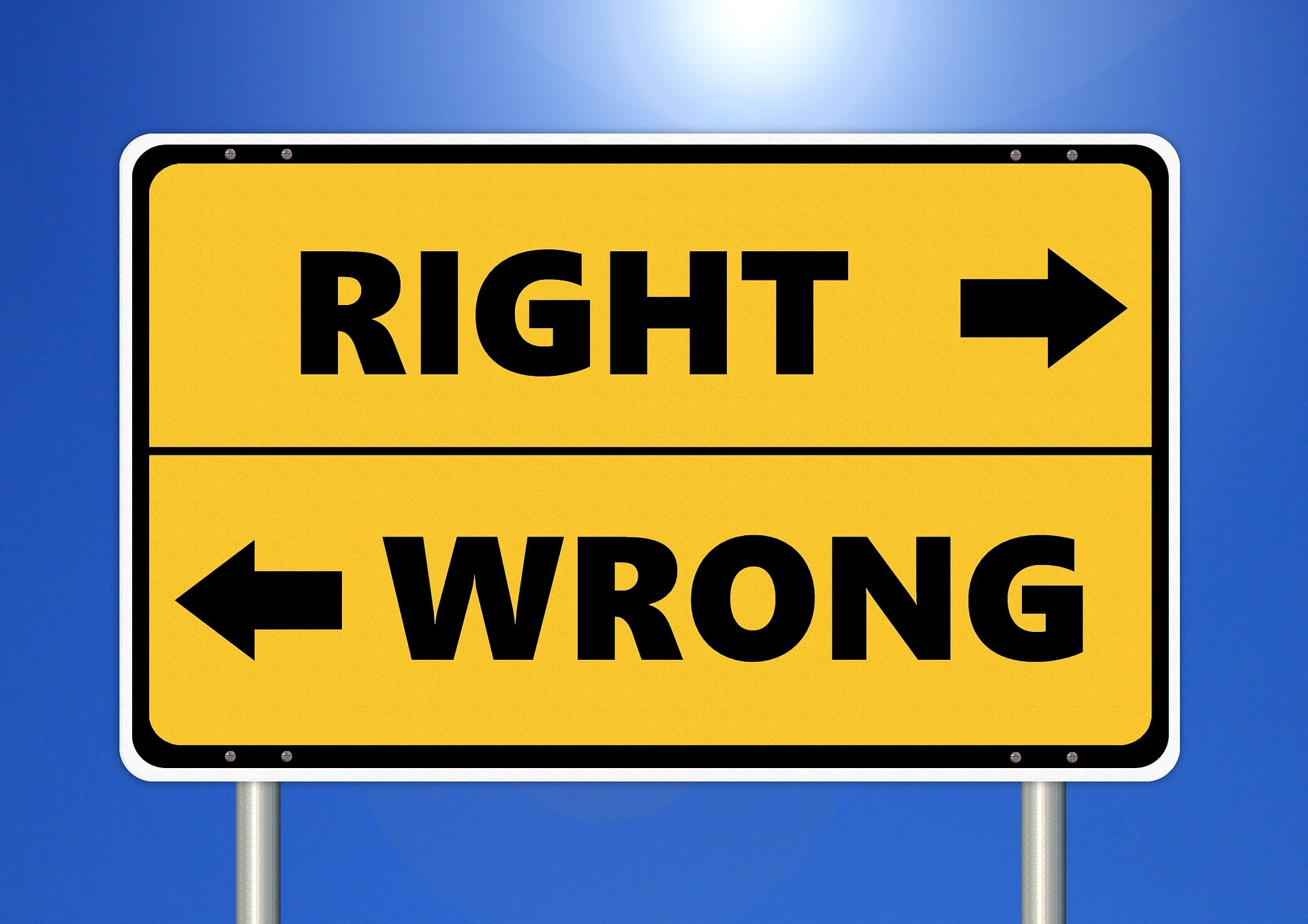
In 2019, rising numbers of consumers will demand SUPERHUMAN RESOURCES: ethical AI and algorithms that deliver fair and unbiased decisions.
TrendWatching
Technology has been caught up in various scandals over the years. Google, Facebook, Amazon, Apple – they were all involved in scandals regarding copywriting, fake news and numerous law infringements. They all promised to democratize information, but they failed to mention the costs for their users.
On some occasions, the use of AI and algorithms has proved deeply flawed and bias-ridden. Cases in point:
- The facial recognition systems created by Microsoft, IBM and Megvii (Chinese company) were proved to lack reliability when they analysed faces of other races except white male;
- Amazon’s facial software used by some police departments and other organizations have incorrectly matched 28 members of Congress with people who had been arrested;
- Another AI based technology developed by Amazon was its recruiting engine; as it turned out, the engine was biased against women.
Reports have found that 97% of consumers now expect brands to use technology ethically (source: we-worldwide.com).
Beginning with 2019, consumers are holding companies accountable for the way they use tech. They are not only watching them closely, they are telling brands what they should do. Brands are way past the days of saying to the public “we’re just a platform, a medium, we are not responsible for how users use our platform” which was Mark Zuckerberg’s official stand in the immediate days following the Cambridge Analytica scandal.
It’s not just about what tech brands can do anymore. It’s about what they SHOULD do — to protect their users, to champion free speech while minimizing the harm toxic words can cause, and to create a better, more just society where information and communication tools are accessible to all.
In the aftermath of the scandal, Facebook made a 180 degrees move and began developing and implementing various programs to fight fake news, become GDPR compliant and more recently, to use AI responsibly. In an article on the Facebook code platform, the tech company has expressed its commitment to research and develop AI tools while applying questions of ethics, fairness and trust.
Our efforts to eliminate algorithmic bias and irresponsible AI deployment include careful consideration of the code we generate as well as the people we hire to write, manage, and approve those AI systems.
Facebook’s approach to a responsible AI starts with the human factor – the people writing the code. The company states that it has adopted a more inclusive hiring strategy with the belief that a “diverse workforce might prevent some problems in the planning stages of a project by bringing more points of view to the table”. If the problem escapes human eyes, the company has processes and tools in place to capture the respective issue during development. If these tools also fail to pinpoint the problem, Facebook’s last resort is the Fairness Flow, an internal tool which measures how an algorithm interacts with specific groups of people.
Your Turn
What can you do to make sure your company’s AIs are ethical and unbiased?
If AIs are not part of your company’s make up, you can still join in this trend.
Explore how your company can put AIs to good use and discover with their help important insights or start conversations around sensitive subjects.
5. FANTASY IRL
In 2019, fanciful worlds will permeate the real world as never before. As consumers seek out FANTASY IRL and play on the blurring boundaries between real and imagined, smart brands will join in the fun!
TrendWatching
The number of brands using augmented reality and virtual reality to attract, delight and retain customers has increased over the past years.
Let’s not forget the Pokémon Go craze which had millions of people worldwide playing the game in 2016.
Big brands such as Nike and BMW have delivered augmented reality powered campaigns on Snapchat.
Ray-ban, IKEA and Sephora built their own AR-based apps to ease the decision making of their customers.
Seeing this rising trend, Google announced the introduction of AR for the web, helping brands delight their website visitors with on-site AR experiences. Or you can open inter-dimensional portals.
According to emarketer.com, the global augmented reality ad revenues are expected to top $2 billion by 2022.
The virtual reality market is also on the rise with the consumer virtual reality software and hardware market expected to grow to $14.5 billion by 2021.
Your Turn
Augmented reality is already a generating revenues reality for brands using this technology. Brands are slow to adopt and implement virtual reality strategies because it involves hardware which is still costly to the average consumer.
But efforts are made towards making the VR software and hardware more easily adopted by the mainstream market.
Playing with virtual and digital tools is a lot of fun! How is your company going to offer this kind of entertainment to its consumers?
Join the Conversation
We’d love to hear what you have to say.
Get in touch with us on Facebook and Twitter.
Goodbye, Marketing Funnel! Hello, Customer Flywheel!
At the 2018 Inbound Marketing Conference, Brian Halligan, CEO at HubSpot broke the big news:
HubSpot was closing the door on the company’s sales and marketing funnel and adopting a new model – the Customer Flywheel.
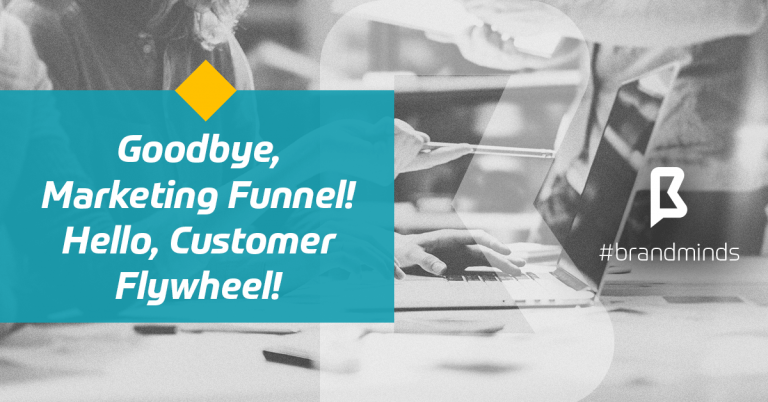
A declared supporter of models, Brian said that for the past 10 years, the funnel worked great for HubSpot. Sales and marketing were feeding the funnel with prospects and leading them towards the top with valuable content and sales conversations. Attract, convince, delight.
It all changed two years earlier when HubSpot noticed that their customers were being convinced to buy HubSpot products by an acquaintance or friend who was already a HubSpot customer. As Brian put it:
The loudest voice in their customers’ head were not sales and marketing any longer but word of mouth.
A Sign of The Times – Shift of Trust from Brand to Customers
Drawing on this insight, Brian recommends brands do as follows:
- Trust your customers to convert your prospects into new customers;
- Acknowledge that word of mouth is your brand’s most powerful channel;
- Shift your mindset from the customer being an output to the customer being an input.
How can brands do that? By adopting the Customer Flywheel.
What is a Flywheel?
A flywheel is a rotating disk used as a storage device for kinetic energy and it pretty much looks like this.
James Watt contributed to the development of the flywheel in the steam engine in the 1800s.
His flywheel was foundational to the Industrial Revolution because it was highly efficient at capturing, storing, and releasing energy.
Will the Customer Flywheel revolutionize business growth in 2019?
HubSpot seams to think so.
Flywheels represent a circular process where customers feed growth.
Jon Dick via hubspot.com
The rules are changing – From Sales & Marketing Funnel to the Customer Flywheel
It’s 2019. What do you need to build a great company?
Up until now, the answer was: a product 10x better than your competition.
Brian believes the answer has changed: the secret to build a great company is to provide a customer experience 10x lighter than the competition.
It’s not what you sell; it’s how you sell.
Brian Halligan, CEO@HubSpot
The Customer Flywheel – The Best Way to Find New Customers
Brian Halligan says the funnel is flawed because it fails to capture momentum.
According to this model, the company puts all its efforts into pushing them through all the stages of the funnel only to close the door behind them once they become customers. It’s like when you had a good time with your date, but you don’t call the next week to repeat the experience. It’s a wasted opportunity!
We all know that it’s harder and more expensive to attract a new customer. Why not make the most of your current customers? Instead of giving them the cold shoulder, start a relationship and turn them into brand advocates. The work is not done once your sales rep converted the prospect to a customer. The work has just begun!
The funnel can’t conceive of customers buying from you more than once, so the momentum you build acquiring customers via the funnel just falls away.
Marketingland.com
The Customer Flywheel leverages the enthusiasm of existing customers and turns it into a driving force for attracting new customers. In his speech, Brian said HubSpot has applied all its energy and force to sales and marketing like all brands have in the past a hundred years. Beginning with 2018, the company has shifted its centre of gravity away from the funnel and applied more force towards delighting their existing customers.
Funnels produce customers, but don’t consider how those customers can help a business grow.
James Gilbert via Marketingmag.com.au
What makes the Customer Flywheel spin?
Force and friction are the two dynamics that directly influence the spin of the flywheel.
What makes the flywheel spin faster and faster? Increased force and reduced friction. The more force with less friction applies to the flywheel, the faster it spins. Once the flywheel gains momentum, it can spin forever with little effort from the company.
Once your flywheel is spinning, momentum comes from retaining customers and transforming them into promoters who will advocate for your brand and even bring you knew business.
Jon Dick via hubspot.com
Here’s what brands need to do to keep their Customer Flywheels spinning according to HubSpot:
1. Increase speed
To make your flywheel spin fast, your company needs to align its sales and marketing. Misalignment of sales and marketing departments leads to flywheel slowing down. If you want to increase the speed of your flywheel, improve your conversion rates, delight customers at scale and address the issues that cause your company to churn customers.
2. Reduce friction
Traditional organisation of the company is the source of friction in a flywheel model. Silos, handoffs, and specialization all create friction. Find the inefficiencies where your customers are losing momentum and make them better.
3. Heaviness
Work towards getting a heavy flywheel. Heaviness is reached by acquiring more and more customers. A heavier flywheel means it is producing more energy when spun. It’s physics! The more your customer count increases, the more growth is your flywheel producing. You can generate even more momentum by getting your customers to adopt more of your products.
Three Benefits of the Customer Flywheel according to Eric Baum of bluleadz.com:
- It’s self-perpetuating;
- It requires alignment;
- It’s relationship focused.
Why is the Customer Flywheel working so well?
The Customer Flywheel is the solution to the challenges the sales and marketing people are experiencing today:
- decrease of brand trust;
- increase of word-of-mouth;
- decreased effectiveness of marketing campaigns which focus on running too many sales activation-based campaigns to the detriment of brand building activities.
Learn more: Your Marketing Campaigns Are Less Effective
[bctt tweet=”In 2019 successful brands will turn customers into brand advocates and morph into a customer-centric company.” username=”brand_minds”]
Main takeaways if you are committed to implementing the Customer Flywheel:
- Examine what forces your company needs to apply to make the flywheel spin – activities, programs etc;
- Identify the frictions and work towards reducing them as much as possible;
- Gain new customers by turning your current customers into brand advocates;
- Find new ways to maximize delight;
- Set alignment between departments as your 2019 organisation goal;
- Begin the process by which your company will embrace customer centricity in 2019.
Join the Conversation
We’d love to hear what you have to say.
Get in touch with us on Facebook and Twitter.
sources:
https://hbr.org/2018/11/replacing-the-sales-funnel-with-the-sales-flywheel
https://blog.hubspot.com/marketing/our-flywheel
https://www.bluleadz.com/blog/funnel-vs.-flywheel
https://www.rakacreative.com/blog/marketing-strategy/how-and-why-to-convert-your-funnel-to-a-flywheel/
https://marketingland.com/from-funnel-to-flywheel-249765
https://www.marketingmag.com.au/hubs-c/opinion-gilbert-funnel-flywheel/
This App Helps Your Brand Create Video With Your Audience
Video is one of the best mediums brands can use to send their message to their audience and the latest statistics detailed in Video Marketing Statistics 2018 – How Brands used Video for Business support this view.
But more often than not, brands create highly polished, scripted and heavily edited videos. The downside: these videos come off as inauthentic which leads to low engagement levels. To win the video content battle, brands need to create videos that are authentic, less polished or scripted.
User-generated content, may it be image, text or video is one of the best sales and marketing tool that a brand can leverage. To mention just two brands off the top of my head that use this tool efficiently: Apple and GoPro. Apple’s Instagram channel is made entirely of photos taken by Apple users and GoPro publishes its customers’ videos on its YouTube channel.
Brand storytelling has been a buzzword for the past years and yet so many brands find it challenging. One of the reasons is the difficulty of creating content which resonates with their audience.
What if there was an app that could bring together video, UGC and storytelling in one powerful product?
The app exists, it was launched in 2014 and its name is Seenit.
What is Seenit?
Seenit is an app and online platform enabling businesses to create community driven video content.
The app transforms the way brands and organisations create with their communities. It helps organisations empower their fans, customers or employees to create video content that is relatable and authentic.
By using Seenit, brands put video production into the hands of those closest to the story. It is an easier way to direct, collect, and curate user-generated content anytime, anywhere.
Our platform enables organisations and brands to create engaging, multiperspective videos with their communities. Telling stories that truly resonate has never been easier.
The Story behind Seenit
When Emily Forbes was working as a documentary maker, she attended a protest against poaching in South Africa. While filming, she noticed a lot of protesters were also capturing the experience on their smartphones. She realized that her documentary would be incomplete without the perspective of the protesters, so she asked them to send her their videos. The result was a rich video content documentary featuring authentic shots filmed at the heart of the protest. That’s how the idea of Seenit was born.
Seenit’s Mission
Communication has evolved significantly and in turn traditional methods have become less effective. As people rapidly consume and create content from all angles to satisfy their needs, how can brands and organisations cut through the noise and create something truly relevant for their audiences?
We believe that everyone has a unique and important perspective to share and that’s what makes this world vibrant and interesting!
The world is a better place when everyone has a voice.
About Seenit
- Seenit was launched in 2014 in London, UK by Emily Forbes, a former documentary maker and producer;
- It reached 100 customers to date;
- Over 220.000 uploads hit;
- Over 150.000 platform users.
Our mission is to give everyone a platform to tell the stories they are most passionate about, with the people that care the most.
How Seenit works
- Shot list – use the online studio to create a project brief and filming directions for your community;
- Capture – invite your community to film on the mobile app;
- Collect – review and curate uploaded footage collaboratively from within the online studio;
- Edit – use built-in post-production software to create finalised video edits.
We believe in amplifying the real voices and stories of the world to encourage a more open and connected community.
Brands using Seenit
Benefit, The Body Shop, The Hut Group, Marks and Spencer’s use Seenit to capture video from their own customers or employees.
BBC, NBC Universal and other broadcasters are creating video content with superfans around the world.
Large corporations like HSBC, City Bank, Accenture, EY are using Seenit to champion the voices of their employees.
We believe the people who are the most passionate and most knowledgeable about a brand or subject or product should be at the front of the story.
Emily Forbes, founder of Seenit via uktech.news
Benefits of Seenit
- Grow your community organically;
- Engage with your fanbase in an authentic way;
- Co-create authentic video content;
- Increase brand trust;
- Create influencers;
- Build brand loyalty;
- Give your audience a voice;
- Increased control legally and creatively (permissions are granted on signup to the app) as opposed to YouTube and Facebook;
- Brand Storytelling;
- Increase brand engagement.
Join the Conversation
Get in touch with us on Facebook and Twitter. We’d love to hear what you have to say.
source: https://seenit.io/
3 Brands in Crisis in 2018: KFC, Nike, Victoria’s Secret
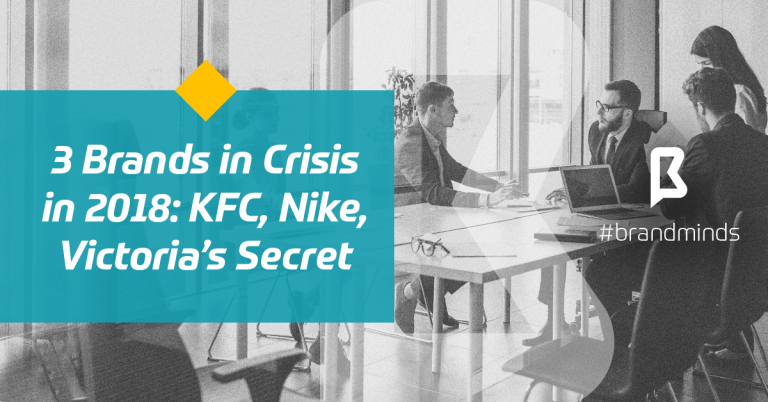
Crisis. A word feared by all brands. No brand wishes to experience crisis and yet unexpected events, reactions or consequences do happen. What sets great brands apart from the rest is the way they manage crisis.
Let’s see how KFC, Nike and Victoria’s Secret managed crisis in 2018!
KFC
In February 2018, KFC runs out of chicken which leads to 900 restaurants across UK and Ireland closing their doors for a few days. The reason? DHL, KFC’s current shipping agent failed to deliver fresh chicken to the said restaurants.
Reactions
Finding their favourite fast-food restaurants unable to sell their delicious chicken menus, people didn’t hold back on expressing their disappointment. They turned to social media to cry out their frustration under #KFCcrisis.
Others contacted police in large numbers.
Please do not contact us about the #KFCCrisis – it is not a police matter if your favourite eatery is not serving the menu that you desire.
— Tower Hamlets Police (@MPSTowerHam) 20 februarie 2018
How did KFC deal with the crisis?
- The company set up an online service where those who couldn’t wait for fried chicken could find the nearest branch that remained open.
- The company published an apology ad as a full-page advertisement in UK newspapers.
FCK
WE’RE SORRY
A chicken restaurant without any chicken. It’s not ideal. Huge apologies to our customers, especially those who travelled out of their way to find we were closed. And endless thanks to our KFC team members and our franchise partners for working tirelessly to improve the situation. It’s been a hell of a week, but we’re making progress and every day more and more fresh is being delivered to our restaurants. Thank you for bearing with us.
Visit kfc.co.uk/crossed-the-road for details about your local restaurant.
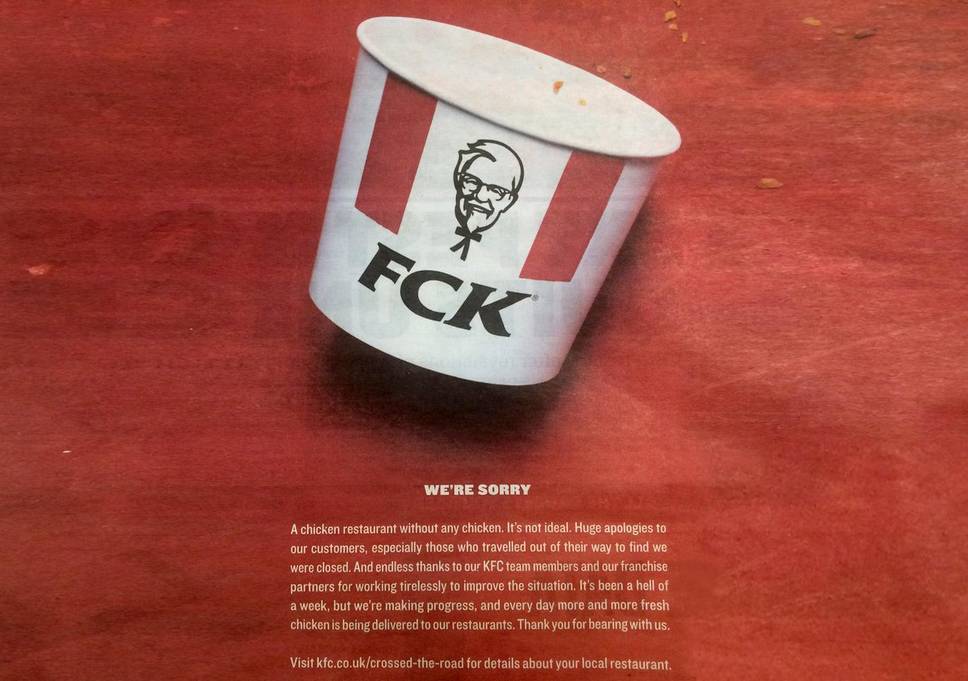
Conclusion
KFC crafted an apology ad using humour and honesty in an authentic way which attracted a lot of media coverage and brand love from its customers.
NIKE
Nike published its Dream Crazy ad on September 5, 2018 with Colin Kaepernick as the narrator. In just three months, the video gained over 27 Million views making it the brand’s most viewed ad on YouTube.
Colin is a former NFL player who attracted outrage from the public when he protested against police brutality by kneeling during the American anthem. Because of his controversial profile, Nike’s ad received a lot of media coverage, mixed reviews and strong emotional feedback from the public.
Reactions
Here are some of the reactions Nike received in the days after the ad was launched:
- Some people set their Nike sneakers on fire;
- #boycottnike became a trending hashtag on Twitter;
- Others cut the Nike logo off their socks;
- Nike’s share price dropped by 3.2% to finally go up to an all-time high, earning the company $6 billion.
Nike is on the right side of history with this ad.
Spike Lee, Film Director
Realeyes, the emotional intelligence platform analysed the overall sentiment towards Nike by looking at the ad’s viewers’ comments.
What did the consumers really think of Dream Crazy?
Here it is according to Realeyes:
- 50% of negative verbatims are about Kaepernick, not the ad itself;
- Negative emotions are due to narrative, not Kaepernick;
- Men garnered more negative emotions;
- Women instinctively more positive towards the ad;
- Middle-aged demographic the least positive.
Some analysts were asking this rhetoric question:
What was Nike thinking about?
The answer is: although Dream Crazy divided the public into supporters and detractors, Nike knew exactly what it was doing.
Actually, the brand has a 30-year experience with controversial, out of the mainstream ads. Dream Crazy is the epitome of a series of risky ads which began with the first JustDoIt ad published back in 1988. Over the next years, the brand’s ads supported various social subjects such as gender equality, woman empowerment, sexual minorities, ageism, disability etc. With each controversial ad, Nike revenues have grown exponentially.
How did Nike deal with the crisis?
Faced with the outrage of some of his customers, Nike has taken no steps to address this crisis.
Nike doesn’t shy away from risk and controversy because starting the conversation on important social subjects stands at the core of its brand values.
It’s safe to say the company has run the numbers before publishing the ad and was ready for any backlash it might have had. According to an ESPN Twitter poll which asked their followers how the ad affected their decision to buy Nike products: 29% said they are more likely to buy Nike products, 21% say they’re less likely and 50% said their decision has not been affected.
Conclusion
Dream Crazy was aimed at the younger generations with the purpose of increasing their fan base. Millennials are known to love and support brands which are committed to their core values and are not shy to stand by them.
According to Edison Trends, Nike’s online sales jumped 25%.
It looks like Nike have taken a controlled risk and came out on top.
VICTORIA’S SECRET
Victoria’s Secret has been experiencing brand crisis for the past few years and its management is slow to even recognize it let alone address it effectively.
Management myopia
The company is currently facing decreased sales and shrunken profit due to management myopia. Here on the BRAND MINDS blog, I have written about myopia as an early symptom of brand failure in our Failure Series articles: Nokia and Kodak.
Far from me to assume the role of Pithya, but as history has shown, if the company loses its grip on reality and doesn’t embrace change, the chances of survival are getting smaller every year that goes by.
Victoria’s Secret has never changed, but the world around them has. I was walking through the subway station the other day in Manhattan and I looked at the ad for the Angels’ ‘fantasy’ runway show and I said to myself: ‘That could be today, or 30 years ago.’
Michelle Cordeiro Grant, former senior merchant director at Victoria’s Secret via theguardian.com
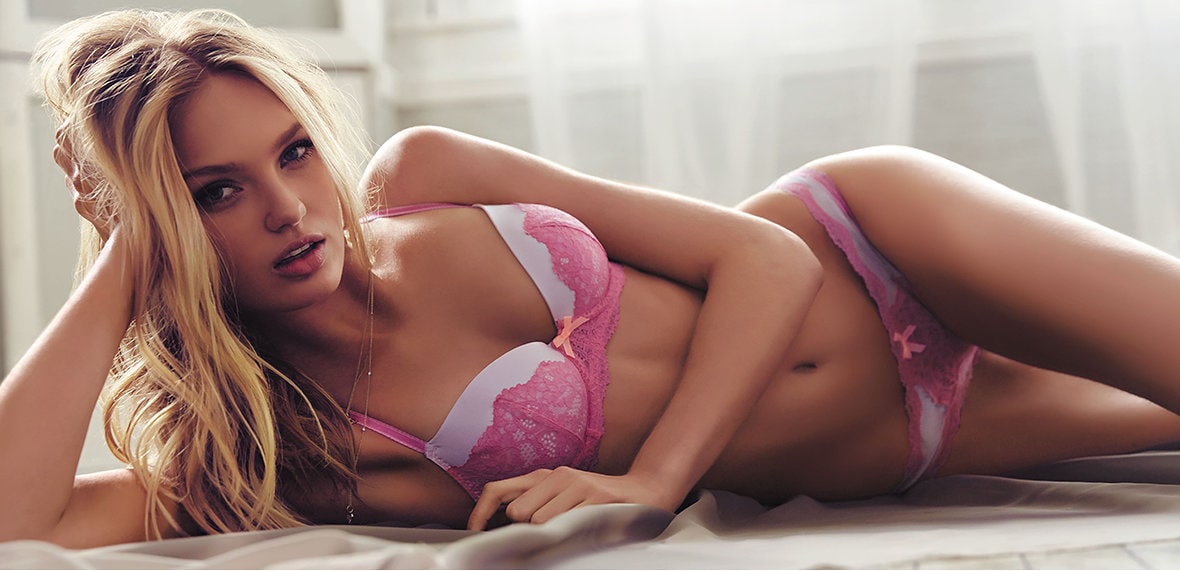
image source: victoriassecret.com
Over the past few years, the company was faced with backlash from the public regarding various subjects such as competitive anorexia that Victoria’s Secret models are suffering from, Photoshopped ad campaigns and the Victoria’s Secret show which the US’s National Organization of Women (NOW) dubbed as “softcore porn infomercial” in 2002.
Mr. Razek’s Vogue Interview
The latest scandal which brought Victoria’s Secret into the spotlight is the interview of Ed Razek, CTO published by Vogue Magazine in July 2018. In this interview, the brand’s problems became clear to everyone: lack of inclusiveness, lack of sexual diversity, disengagement with its customers’ needs and expectations, outdated marketing.
Mr Razek’s words attracted the outrage of female public. Essentially, Mr. Razek said that Victoria’s Secret supports the woman as long as she portrays herself as the object of the heterosexual white male’s fantasies.
Victoria’s Secret is losing share to other brands because it’s out of touch. The way it’s marketing is out of touch. Women don’t want to be viewed as stereotypical sexy supermodels buying lingerie just to impress men.”
Paul Lejuez, retail analyst focused on L Brands via nytimes.com
Victoria’s Secret, founded by Roy Raymond in 1977 is seeing increased competition from other lingerie brands such as ThirdLove, Aerie and Savage x Feinty by Rihanna, startup companies founded by women.
These companies feature real women in their advertisements, of all sizes, shapes and colours. While Victoria’s Secret designs its products with the white male in mind, their products are designed to meet women’s needs of comfort, beauty and sexiness.
Following the Vogue interview, ThirdLove published an open letter and launched a petition to boycott the Victoria’s Secret fashion show this year in an attempt to force the brand to “be more diverse and inclusive of body shapes and sizes on their runways.”
Women are tired of trying to comply to Victoria’s Secret’s narrow standards of sexiness and are looking for brands which support a healthy body image.
How did Victoria’s Secret deal with the crisis?
The first step following Mr. Razek’s interview was Jan Singer stepping down as the company’s CEO. No other measures have been announced so far.
Conclusion
The company is in dire need of re-branding and re-evaluation.
Women have changed since the 1980s and if the brand doesn’t keep up with its clients, it will get out-marketed and out-competed by other lingerie brands.
Although a lot smaller than Victoria’s Secret, these brands are more in tune with their customers. And this is the winning recipe.
sources:
https://www.forbes.com/sites/andriacheng/2018/07/12/heres-the-real-problem-behind-victorias-secrets-dramatic-fall/#7ecb280a1054
https://www.forbes.com/sites/andriacheng/2018/11/19/victorias-secret-facing-a-slide-in-sales-and-profit-is-in-need-of-a-new-brand-pitch-fast/#15e79acf4d70
https://www.vogue.com/article/victorias-secret-ed-razek-monica-mitro-interview
https://www.teenvogue.com/story/thirdlove-response-victorias-secret-ed-razek-interview
https://www.forbes.com/sites/yolarobert1/2018/11/26/victoriassecretreplacesceo/#21bbeb246194
https://www.vox.com/the-goods/2018/11/8/18068148/victorias-secret-fashion-show-2018-history-controversy
https://www.theguardian.com/lifeandstyle/2018/nov/22/victorias-secret-show-angels-lingerie
https://www.telegraph.co.uk/news/2018/02/20/kfc-chicken-shortage-causes-chaos-police-tell-customers-stop/
4 big brands using drones for business

We’ve grown accustomed to kids and teenagers using drones for fun.
Or grown-ups using a different kind of drone for aerial selfies or astonishing videos (see here).
But how about brands using drones for business?
This article presents you with 4 brands and how they use drones to improve their business.
Here are 4 brands using drones:
-
Dolce&Gabbana
Fashion shows are not all about the clothes. Some fashion designers go to great lengths to make an impression upon the audience and land as much media coverage as possible.
British designer Anya Hindmarch put on a fun and colourful set made out of 50,000 dominoes for her 2013 show. Karl Lagerfeld finished his 2017 show with a rocket taking off from the runway in the Grand Palais.
The latest fashion house to enter the hall of eccentric runway shows is Dolce&Gabbana. For its 2018 eveningwear event, Dolce and Gabbana used drones to show its handbags collection. It’s certainly a first for the fashion world!
-
AIG
AIG specializes in aviation insurance, with many of their employees in this line of business being qualified pilots.
In 2015, the company received the FAA approval to operate small unmanned aerial vehicles – drones. AIG is one of the early drone users in the industry and uses them to replace human inspectors.
Since 2015, their fleet of drones has conducted inspections for risk assessment, risk management, loss control, and surety performance for customers in the U.S. Using drones instead of human inspectors helped AIG accelerate surveys of disaster areas with high resolution images for faster claims handling, risk assessment, and payments. Drones are also beneficial in that they can reach areas that could be dangerous or inaccessible for manual inspection. Also they provide richer information about properties, structures, and claim events.
-
Intel
Intel’s leaders believe drones are an important computing platform for the future. And they have foreseen their usage in two sectors: commercial and entertaining.
In 2016 Intel entered the drone manufacturing market by acquiring MAVinci GmbH – a private fixed-wing company with best-in-class flight planning software. The same year, Intel announced their first Intel-branded commercial drone, the Intel® Falcon 8+ System and their first drone designed specifically for light shows: the Intel® Shooting StarTM drone.
In 2018, the most notable project Intel is running is the restoration of China’s Great Wall with the help of its drones and artificial intelligence technology.
-
Project Wing
Alphabet, Google’s parent company has been testing drone delivery to people’s backyards in Australia since 2014. Under the name Project Wing, the end goal is certainly ambitious:
“A new method of transporting goods that’s faster, cheaper, and more environmentally friendly than what’s possible today on the ground.”
So far, Project Wing managed to transport successfully a first-aid kit, candy bars, dog treats, water to farmers and burritos to students at Virginia Tech.
In July 2018, Project Wing announced its separation from Alphabet.
3 Snapchat Campaigns powered by Augmented Reality
Snapchat is undoubtedly leading the user experience of augmented reality in social media. In 2016, the Pokemon GO frenzy took the world by storm and showed the incredible appeal of AR for users.
In the following years, brands have looked for ways to use AR to raise engagement on Snapchat and draw users’ attention to their products.
Discover 3 brand campaigns powered by augmented reality and delivered through Snapchat:
BMW
As part of its 2017 ad campaign to launch the BMW X2, the famous carmaker became the first brand to create a 3D augmented-reality version of a product with Snapchat.
During the campaign, consumers on Snapchat began seeing ads from BMW that linked to the augmented-reality version of the new car. When someone swiped on the ad, it opened the camera and the gold car appeared in the frame. A person could then virtually walk around the car and see all its details and even change its color.
Nike
Nike partnered with Snapchat and Shopify earlier this year for the pre-release of Air Jordan III Tinker. 2018 marks 30 years since Michael Jordan made history with his free throw line dunk in 1988 Slam Dunk Contest win. It is one of the most memorable moments in NBA history and Nike wished to celebrate it.
Using 3D and augmented-reality technology, Nike brought Michael Jordan through Snapchat to the younger generation that has never seen him play. But the experience didn’t stop here. With a tap on the screen, the user was able to purchase a pair of Air Jordan III Tinker which was delivered to their home address within two hours. The pre-release shoes were sold out in 23 minutes.
Watch the video here.
Foot Locker
The holidays tend to bring out the best in advertising, leading to fierce competition to make an impact. This often means clever brand partnerships.
One such example is the collaboration between Foot Locker and Snapchat on Christmas 2017. Foot Locker designed an unboxing experience for Snapchatters in which they delivered animated Jordans that users could customise and dunk.
How Luxury Marketing Will Look Like in 2018
The concept of luxury is changing, just like everything we are surrounded by is, like our preferences and sometimes passions. Consumer expectations of luxury continue to rise, and that what used to be luxury is now seen by the current generation of consumers, everyday experiences. And, as always, technology has a big part in this change as it makes everything easier,closer and more affordable, therefore what some years ago was considered luxury today might not be so. And just like what today is luxury in the years to come might not be anymore. The definition of luxury is changing, while “upper luxury” appears.
According to Deloitte’s “Global Powers of Luxury Goods 2018”, the world’s 100 largest luxury goods companies generated sales of US$217 billion in FY2016 and the average luxury goods annual sales for Top 100 companies is now US$2.2 billion. The report discusses the trends and issues that are driving the luxury industry. It also identifies the 100 largest luxury goods companies based on publicly available data for FY2016 (which they define as financial years ending within the 12 months to June 2017), and evaluates their performance across geographies and product sectors.
The growing importance of non-western markets for the luxury goods industry has been supported by supply chain leadership, technological innovation and international investment. These factors will help maintain further strong
growth in these geographical markets.
Deloitte’s “Global Powers of Luxury Goods 2018” points out:
Luxury brands have refocused their business strategies to capitalise on these changes. Giorgio Armani is engaged in an in-store installation collaboration agreement with Colombian artist Marta Luz Gutiérrez, while Louis Vuitton is conducting an advertising campaign using a
building designed by the late Mexican architect Luis Barragán. Rising prosperity in major cities and growing formal market power over the black market will ensure sustained Rest of the World (ROW) demand for luxury goods. To succeed in this context, luxury players should focus their investments on digital connectivity, upwardly mobile consumers and bold business models, which are key components of the
personal luxury industry today.
Some aspects that marketers must pay attention and act on in 2018:
Still according to Deloitte, collectively, Millennials and Generation Z will represent more than 40 per cent of the overall luxury goods market
by 2025, compared with around 30 per cent in 2016. Unlike Baby Boomers, many Millennial luxury consumers expect to interact with brands across a range of digital platforms, rather than only through traditional channels. Millennial consumers are also important for in-store shopping and expect a high-value, customized experience. Luxury brands should seek to change their business models to meet this demand, for example by providing more loyalty
programs and invitations to in-store events.
Customize your approach according to your audience. Personalization is still key as a marketing technique to be used as 45% of luxury consumers are asking for personalized products and services. With different expectations, younger
shoppers seek a personalized shopping experience that seamlessly integrates both online and offline platforms. This shift has motivated demand for connective technology such as Augmented Reality (AR) and Artificial Intelligence
(AI). By using AR and AI technologies, luxury brands can provide a personalized consumer experience, reach a wider audience, deepen product experience, and build stronger customer relationships. In parallel, the development of technologies such as voice commerce and the Internet of Things (IoT) are reshaping the entire luxury industry.
Luxury brands positioned as reliable sources of AI-driven recommendations are improving how they engage with consumers. More widespread adoption of AI is also making consumers increasingly reliant on suggestions and advice
provided by their various devices, rather than making decisions based on personal experience.
Social media becomes an important marketing tool for luxury as well. Instagram became the leading social media platform for fashion designers. Gucci more than doubled its Instagram followers between 2016 and March 2018, with successful Insta-campaigns such as #TFWGucci.
In future, the biggest challenge for luxury brands will be to make optimum use of social media without compromising their brand values. The success of a social media strategy will be converting “likes” into an interactive and engaging experience for customers.- Deloitte
An omnichannel approach – onnichannelluxury
A true omnichannel global market environment would require luxury brands to close gaps in customer experiences across channels, to offer a seamless, unified brand experience irrespective of the device or physical touchpoint used. Therefore, each channel needs to interact with and support
others to establish a single brand presence. Demand for an omnichannel approach is a natural development from the spread of digital technology and
e-commerce markets. During this process of change, the ability of luxury brands to leverage available inventory will be a key differentiator.
Digital must remain a priority to define an omnichannel strategy compatible with target expectations. The percentage of online sales perceived as being additional, and not a cannibalization of, physical sales is decreasing each year, with China the least cannibalized country to date.
“Luxury brands should develop their mobile strategy: 55% of luxury consumers buying online use their mobile phones versus personal computers. Peaks appear among the youngest generations and Chinese consumers, 75% and 77%, respectively, of whom use mobile. Social media and influencers are gaining power. For the first time, social media is the first source of information and the channel of primary impact used by true-luxury consumers, followed by magazines and brand websites. Five platforms (Facebook, Instagram, WeChat, Weibo, and QQ) are dominating the social media world, but Facebook is losing momentum to Instagram in the Western world and QQ is losing momentum to WeChat and Weibo in China,” states in “True-Luxury Global Consumer Insight”, the fifth edition of an annual study by The Boston Consulting Group (BCG) and Altagamma.
Millennials: Consumer Aspirations Are Disrupting Luxury
Collaborations with streetwear brands and artists are becoming the norm for Generation Zers and Millennials. “Collaboration covers demand for newness in a less risky way. It gives brands a cool edge and strengthens brand awareness as well as increases willingness to buy the brand. Collaboration is increasingly in demand and turns out to be a very effective purchasing incentive,” said Olivier Abtan, a partner in BCG’s Paris office and the global leader of the firm’s luxury, fashion, and beauty topic.
Unlike “absolute luxurers,” who buy luxury items exclusively, millennials do not hesitate to mix and match. According to BCG’s study, about 55% of this group trades down to buy handbags or T-shirts from cheaper brands, or mixes their style by buying sneakers and luxury shoes from luxury niche brands (including luxury sports). This trend appears to fulfill consumers’ need to create their own style. When they do look for different brands, it’s because luxury brands don’t have offerings in certain categories or because of the Millennials’ desire to have a unique style, express themselves, and seek out niche brands.
Use iconic personalities in your communication
With all the big changes, some things are meant to last and take the test of time. Chanel’s iconic marketing history began with a print advertisement for its perfume, Chanel No.5, in 1921. Its first celebrity endorsement didn’t feature until 1954, with Marilyn Monroe. However, it wasn’t until 2005 when Chanel first adopted videography, and from here, the rest is history.
“Despite not adopting social media and integrating the platform with videography until 2009, its marketing strategy is nothing short of stupendous. Selecting admirable public figures such as Keira Knightley and Nicole Kidman to star in Chanel’s unmistakable short films, revived the brand as an iconic symbol of both cultural and digital relevance. With the use of video and social media integration, Chanel has grown to having more than 57 million social followers globally, the highest in the luxury fashion industry. The brand focused on Facebook as their initial social media platform, due to the video capabilities such as extended video length, that Twitter and Instagram do not support. For the brand’s primary consumer, the more wealthy and mature client, Facebook was the ideal platform for accessing this demographic,” wrote Little Agency.
Sensory Branding
According to Retail Insider, British Airways is encashing big on a recent study on sensory sciences by Oxford about how sound influences the taste of food. Based on the findings of this study, they launched a list of 13 in-flight tracks to enhance the taste of the meals served during the flight, providing a truly luxurious experience. Moreover, Soundwich in Portugal delivered gourmet sandwiches packed in metal boxes that play music chosen by the chef when opened.
More ideas you can see here.
